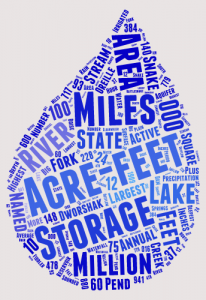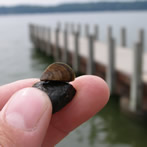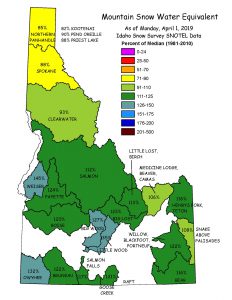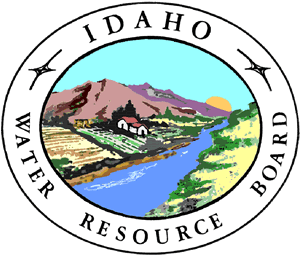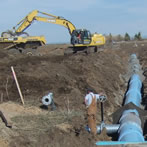Frequently Asked Questions
No, on August 25, 2014, the Final Unified Decree for the SRBA was signed. The opportunity to file a Notice of Claim to a Water Right for a non-deferrable water use is closed.
A small water use for domestic and/or stock purposes can be considered de minimis if the water use meets the following definitions:
- De minimis water use for “Domestic” purposes means:
- the use of water for homes, organization camps, public campgrounds, livestock, and for any other purpose in connection therewith, including irrigation of up to one-half (1/2) acre of land, if the total use is not in excess of thirteen thousand (13,000) gallons per day, or
- any other uses, if the total use does not exceed a diversion rate of four one-hundredths (0.04) cubic feet per second and a diversion volume of twenty-five hundred (2,500) gallons per day.
- De minimis domestic uses shall not include water for multiple ownership subdivisions, mobile home parks, or commercial or business establishments, unless the use meets the diversion rate and volume limitations set forth in definition (b) above.
- De minimis water use for “Stockwater” purposes means the use of water solely for livestock or wildlife where the total diversion is not in excess of thirteen thousand (13,000) gallons per day.
In the SRBA, certain small stockwater and domestic water right holders were not required to file claims during the adjudication, and instead, could opt to defer the filing until a later time. A deferred de minimis domestic and/or stockwater claim is one which was not filed before December 18, 2013, which is the date when the Order Granting State of Idaho’s Motion for Interim Order Implementing the Order Governing Procedures of Adjudication of Deferred De Minimis Domestic and Stock Water Claims was issued in the SRBA.
No, deferrable de minimis domestic and/or stockwater use claims do not need filed immediately. In the Final Unified Decree for the SRBA, the Court specifically states that any domestic and/or stockwater right (as defined in Idaho Code § 42-111) “shall not be lost by failure to file a notice of claim.” Therefore, there is no deadline for filing a deferrable de minimis domestic and/or stockwater use claim.
The Court established a process for filing a Notice of Claim to a Water Right for de minimis domestic and/or stockwater uses that were deferred (not claimed) in the SRBA. The water can only be claimed for domestic and/or stockwater use if the amount of water diverted for domestic and/or stockwater use does not exceed 13,000 gallons per day.
The Court process begins when you file a Motion for Determination of Deferred De Minimis Domestic or Stock Water Use. When you file the motion, you must also file the Notice of Claim to a Water Right.
To help you through this process, visit the Forms page where you can find both forms noted above as well as instructions, checklists, and supplemental forms for federal grazing allotments.
To acquire a new water right from a groundwater source (a well), a water right permit is not required if the water use is limited to watering livestock and the volume of the water diverted or consumed by the livestock does not exceed 13,000 gallons per day.
To acquire a new water right for an out-of-stream diversion from a surface water source (a spring, stream, river, lake, wetland, or naturally-occurring pond), a water right permit is required unless the out-of-stream use meets the criteria of Idaho Code &sec; 42-113(3). Visit the Water Rights Forms page for the Application for Permit form as well as instructions.
If you or your predecessor diverted water from a surface water source for the purpose of watering livestock and the diversion of the water commenced prior to May 20, 1971, or if your livestock drink directly from a surface water source [or through a trough or tank pursuant to Idaho Code § 42-113(3)], you can file a Notice of Claim to a Water Right with the SRBA Court—provided that the volume of water diverted or consumed by the livestock does not exceed 13,000 gallons per day. You can also file a Notice of Claim to a Water Right with the SRBA Court for water diverted or consumed by the livestock from a groundwater source if the volume of water diverted does not exceed 13,000 gallons per day. To help you through this process, visit the Forms page where you can find the Notice of Claim to a Water Right form as well as instructions, checklists, and supplemental forms for federal grazing allotments.
If you or your predecessor diverted water from a surface water source for the purpose of watering livestock and the diversion was commenced after May 20, 1971 [and your diversion does not meet criteria of Idaho Code § 42-113(3)] or the volume of the water diverted exceeds 13,000 gallons per day, you must file an Application for Permit for a new water right. Visit the Water Rights Forms page for the Application for Permit form as well as instructions.
For all complete list of Adjudication claim forms and instructions, visit the Forms page.
As of July 1, 2017, for claims in which stockwater is the sole purpose of use claimed and the use is less than 13,000 gallons per day, the filing fee is $25.00 each for the first four claims. If you file additional stockwater-only claims, there are no additional filing fees for the additional claims.
In the Idaho Supreme Court case Joyce Livestock Company v U.S. (February 9, 2007), the Court held that a cattle rancher can establish an in-stream water right on federal land for the watering of livestock if the rancher had authority to access the federal land to graze cattle. The Court held that such a water right becomes appurtenant to (or attached to) the “base property” or “base ranch” for which the stockwater right was established. The base property is the private land used to support the livestock at the time the water right was perfected.
When filing a claim for a previously-established water right, you must submit evidence of the date when water was first beneficially-used on the federal land. Evidence could include historical documents such as applications for grazing permits.
For more information about the documents you need in order to establish proof of an existing water right, review the Checklist of Items Recommended for Each Deferred De Minimis Stockwater Use Claim. Since a Class 1 Grazing Permit could only be issued if the applicant grazed livestock on the public range prior to the enactment of the Taylor Grazing Act of 1934, the best evidence for establishing a priority date before the Taylor grazing act might be information on the original application for the grazing authorization that led to a Class 1 Grazing Permit.
The Kootenai River Basin does not have a current adjudication. You can record the historic water use in this river basin by filing a Statutory Claim to a Water Right pursuant to Idaho Code § 42-243.
Visit the Water Rights Forms page for the Statutory Claim to a Water Right form as well as instructions.
The Idaho Supreme Court confirmed in the Joyce Livestock decision (Joyce Livestock Company v U.S., February 9, 2007) that owners of livestock grazing on the public domain could establish beneficial use instream (non-diverted) stockwater rights, and those water rights were appurtenant to the owners’ base property (patented private land) rather than the public land where the livestock graze and drink the water.
The original grazing permit and the application that was filed to obtain the grazing permit can be used to establish the water right priority date. If the original grazing permit issued was a Class 1 grazing permit, the permit holder owned base property and grazed the public range prior to the enactment of the Taylor Grazing Act. The copy of the original grazing permit application should also contain information listing how long the applicant had been grazing livestock on the public range.
No, a chain of title for the base property is not required for filing a claim. A rebuttable presumption is made that your base property can be traced back to the original base property associated with the original grazing permit or when water was first put to beneficial use on federal land. However, it could be beneficial to have the chain of title documented in case the presumption is challenged.
Grazing permits can be sold separately from the base property. If the person or entity that is selling the grazing permit established water rights on the federal land, those water rights may be conveyed with the grazing permit if the sales agreement specifically states that the sale of the grazing permit includes the water rights. The seller must be the owner of the base property in which the water rights are appurtenant, or reserved the water rights at the time the base property was sold, and prior to selling the grazing permit. A water right transfer is likely necessary if the water rights were separated from the base property and sold after November 19, 1987 and if the claim is for water usage within the Snake River Basin Adjudication boundary. If the purchase of the grazing permit did not include a water right, a new water right may be established once the new owner of the grazing permit begins watering livestock on the land.
When reviewing the claim, IDWR staff need to verify that the claimant currently has the right to graze livestock at the place of use described on the claim.


